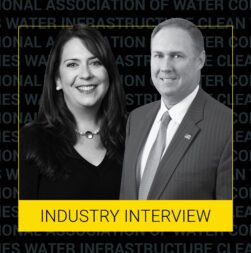From heavy traffic and distracted drivers to dangerous weather conditions, our nation’s roadways can present many hazards. The safety risks increase when combined with poor transportation infrastructure, such as deteriorating roads, bridges, and congested intersections. As an industry-leading, Safety-Driven®, short-term traffic control company, Flagger Force is committed to enhancing roadway safety and keeping our communities moving. We are pleased to see many government agencies and local municipalities addressing infrastructure issues because an investment in infrastructure improvements is an investment in the safety of our communities.
This year, the Ohio Department of Transportation (ODOT) invested a record-breaking $2.8 billion in infrastructure improvement projects. We recently had the opportunity to speak with Matt Bruning, ODOT’s press secretary, to learn more about how the funds will be used, the types of projects that will be completed as part of the investment, and how they will improve roadway safety.
As ODOT’s press secretary, Matt Bruning manages statewide transportation issues and works closely with the media, the State House, legislation, and other partners. He also co-hosts ODOT’s weekly video news series, The Loop, and helps manage the agency’s presence on social media.
Read what Matt shared during our recent conversation to learn how ODOT is transforming their state’s infrastructure to create safer, more effective roadways for motorists, pedestrians, roadway workers, and all residents.
Tell us about the Ohio Department of Transportation.
Matt: ODOT is responsible for maintaining all state and U.S. routes outside municipalities. We also oversee the interstates except for the Ohio Turnpike. In all, we are responsible for about 50,000 lane miles of roadway and over 14,000 bridges. It is a big network that we take care of. At ODOT, safety is a top priority. I am very proud of our efforts to make our roads and bridges safe for all who use them, whether drivers, pedestrians, or bicyclists. We continuously look for ways to improve our infrastructure and make our communities safer.
What roadway safety programs has the Ohio Department of Transportation implemented?
Matt: ODOT has one of the largest programs in the nation when it comes to annual per capita spending. We spend approximately $183 million each year on roadway safety projects. We also use these funds to help our local partners and municipalities maintain and make their roadways safer.
Pedestrian safety is key, especially in Ohio’s major metro areas, so we have invested in improving their roadway systems. One of my favorite programs is Safe Routes to School, which allows school districts and municipalities to apply for funding to improve the paths children take to and from school with a focus on the routes they walk and bike. We have also found that some of the smaller municipalities in the state do not have the technical knowledge needed to make their roadways safer, so ODOT regularly collaborates with them to share our expertise and resources.

Are there any trends the Ohio Department of Transportation is seeing related to roadway safety in and around work zones?
Matt: Unfortunately, we have seen many crashes in work zones across Ohio. That is why we have been doing so much work with our partners at the Ohio State Highway Patrol and other law enforcement agencies. This year, we have ramped up our efforts by targeting 10 work zones where we have identified many crashes. In collaboration with the Ohio State Highway Patrol, we have monitored these work zones from the air. Work zones can be tricky for law enforcement, so aerial enforcement has been very effective. This past summer, we saw an uptick in enforcement and a decrease in work zone crashes. For ODOT, it is not about writing tickets. We would love it if the Highway Patrol were bored because that would mean everyone is obeying the speed limit when traveling through work zones. But unfortunately, that is not the case.
What led to the Ohio Department of Transportation’s record investment in infrastructure improvement projects?
Matt: We have been blessed with a governor who understands how important infrastructure is and the need to invest in the state’s roadways and bridges. When Governor DeWine took office, unfortunately, we faced some challenges when it came to funding transportation. The gas tax was not keeping pace with the cost of maintaining our transportation systems, so he decided to seek an increase in Ohio’s gas tax, modernizing it to current times. That allowed for extra resources and led to this year’s record-breaking $2.8 billion investment in our state’s roads and bridges.
Could you provide an overview of the infrastructure improvement projects currently underway or those planned to be completed as part of the investment?
Matt: We have a lot going on around the state. In Columbus, on the I-70/71 downtown ramp-up, we have a major rebuild underway. This is one of the most crash-prone stretches of interstate highway in Ohio, and we have seen many crashes in the area over the years. As a result, we are restructuring some of the traffic patterns that were fine in the ‘50s and ‘60s when it was built, and the traffic volumes were relatively low. Now, because of the increase in traffic and crashes, we are modernizing the stretch of roadway, which has been quite the endeavor.
A well-known tech company is also making a $20 billion investment in Ohio with a new plant they are building in Licking County. This has required us to add capacity to state route 161 and help the locals with a $95 million investment in their roadway network. We have also been completing projects in the Akron area around the central interchange, as well as on I-76 and I-77.
About 85 cents of every dollar we have invested this construction season has gone into maintaining existing infrastructure, such as resurfacing projects and repairing roads and bridges.

In a recent article, the Ohio Department of Transportation stated that this year’s construction program includes 176 safety projects. Could you tell us about these projects, their specific safety goals, and target outcomes?
Matt: The safety projects we are working on can range from a simple re-striping at an intersection to installing a new roundabout. We analyze different crash types to determine where fatal crashes are occurring versus those that motorists can walk away from. We want to understand where fatal crashes are happening, what is causing them, and how we can prevent similar incidents from occurring again. For example, we know that angle crashes are more dangerous and often result in serious injury or death. Based on this information, if there were an intersection with a high number of angle crashes, we would want to consider installing a roundabout. The goal is to always increase safety and decrease the number of crashes that occur on our roadways.
What safety measures does the Ohio Department of Transportation have in place to protect their roadway workers?
Matt: The safety of our roadway workers is a real concern. Last year, our crews were struck 56 times. That total includes people, equipment, and vehicles. In 2024, our crews have been struck 58 times, and we are just over halfway through the year.
This summer, in collaboration with the Ohio State Highway Patrol and other partners, such as towing companies and emergency responders, we launched a new campaign to remind motorists about Ohio’s Move Over Law. The campaign’s goal is to educate motorists about the state’s law and reinforce that roadway workers are real people with families that they want to get home to at the end of each day. As part of the campaign, we have run videos on social media, streaming platforms, and other channels to raise awareness. We plan to continue pumping resources into the campaign because it has made a difference. Since launching the campaign, we have seen a very sharp decline in work zone incidents.
We also conduct outreach at some of our rest areas across the state. We set up a tent, hand out educational information, and have roadway workers onsite to talk to travelers and remind them that as they drive through Ohio they may encounter work zones and people just like them on or near the roadway. The outreach and personal conversations have been successful.

What message do you have for motorists who may encounter work zones in Ohio?
Matt: Do not think of the men and women performing their duties on or near the roadway as just workers. They are real people with families, friends, hobbies, and all kinds of activities they enjoy. They want to get home safely to all those things. As motorists, when traveling through a work zone, we must slow down, move over when possible, and pay attention to the roadway workers. I want to emphasize paying attention because if you never see the roadway worker, you will never know to slow down or move over. These folks are out there trying to make our roadways safer and better for everyone, the only thing they ask in return is that you do your part to protect them. I do not think that is too much to ask.

At Flagger Force, we are honored to connect with other professionals and organizations that share our commitment to improving roadway safety. We want to thank the Ohio Department of Transportation for all their hard work to enhance our nation’s critical infrastructure and keep our communities moving. We thank Matt Bruning for participating in this insightful discussion and sharing details about ODOT’s 2024 infrastructure improvement program.

